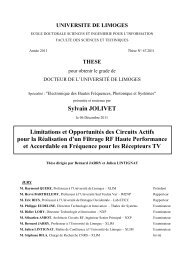Contribution à la conception optimale en terme de linéarité et ...
Contribution à la conception optimale en terme de linéarité et ...
Contribution à la conception optimale en terme de linéarité et ...
Create successful ePaper yourself
Turn your PDF publications into a flip-book with our unique Google optimized e-Paper software.
IV.2.3.4. - Analyse <strong>de</strong> <strong>la</strong> stabilité linéaire <strong>de</strong> l’amplificateur......................... 147<br />
IV.2.3.5. - Caractéristiques <strong>en</strong> puissance ....................................................... 148<br />
IV.2.3.5.1. - Fonctionnem<strong>en</strong>t <strong>en</strong> puissance ................................................ 148<br />
IV.2.3.5.2. - Fonctionnem<strong>en</strong>t multiporteuse............................................... 149<br />
IV.2.4. - Verification experim<strong>en</strong>tale <strong>de</strong> <strong>la</strong> m<strong>et</strong>hodologie <strong>de</strong> <strong>conception</strong>............. 152<br />
IV.2.5. - Pot<strong>en</strong>tiel technologique......................................................................... 158<br />
IV.3. - REALISATION DE L’AMPLIFICATEUR BANDE KU...................................... 160<br />
IV.3.1. - Modélisation du transistor pHEMT TI 1250......................................... 160<br />
IV.3.1.1. - Modèle linéaire ............................................................................. 160<br />
IV.3.1.2. - Modélisation <strong>de</strong>s non-<strong>linéarité</strong>s .................................................... 163<br />
IV.3.2. - Conception <strong>de</strong> l’amplificateur............................................................... 164<br />
IV.3.2.1. - Analyse <strong>de</strong> <strong>la</strong> stabilité linéaire du transistor ................................. 164<br />
IV.3.2.2. - Optimisation du transistor............................................................. 164<br />
IV.3.2.3. - Synthèse <strong>de</strong>s circuits d’adaptation................................................ 165<br />
IV.3.2.4. - Analyse <strong>de</strong> <strong>la</strong> stabilité linéaire <strong>de</strong> l’amplificateur......................... 167<br />
IV.3.2.4.1. - Fonction normalisée du déterminant...................................... 167<br />
IV.3.2.4.2. - Etu<strong>de</strong> <strong>de</strong> <strong>la</strong> stabilité par le facteur K...................................... 167<br />
IV.3.2.5. - Caractéristiques <strong>en</strong> puissance ....................................................... 168<br />
IV.3.3. - Verification experim<strong>en</strong>tale <strong>de</strong> <strong>la</strong> m<strong>et</strong>hodologie <strong>de</strong> <strong>conception</strong>............. 170<br />
IV.4. - CONCLUSION ....................................................................................................... 175
















